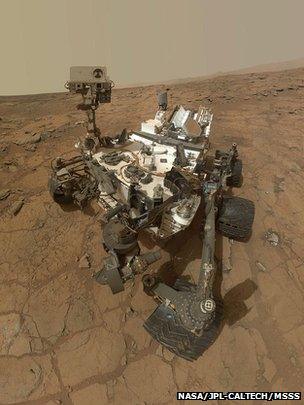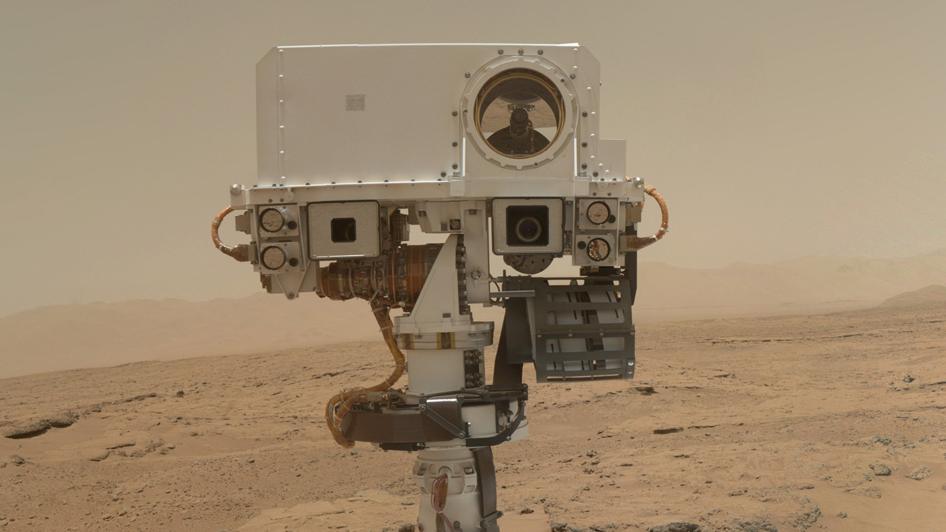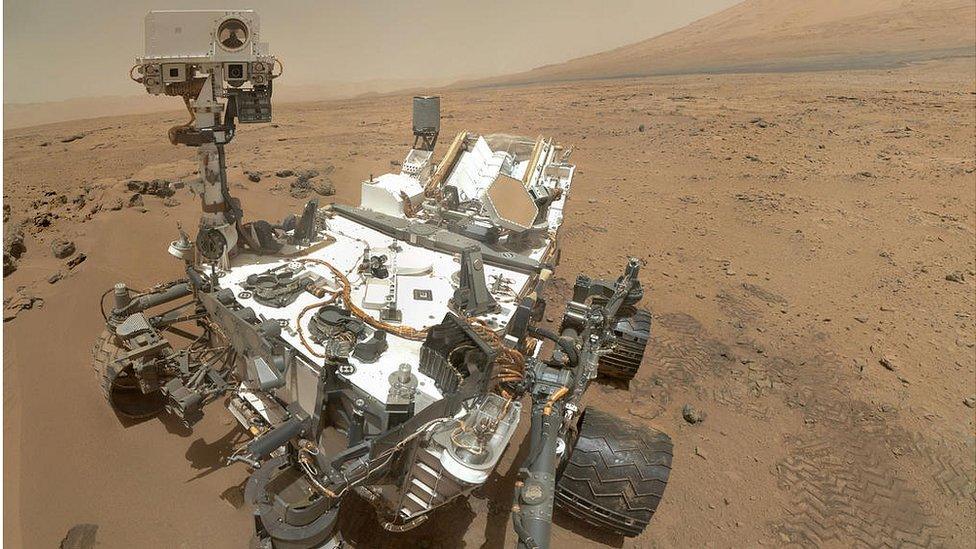Curiosity rover traces loss of Martian air
- Published

Curiosity is investigating a big crater on Mars' equator
The degree to which Mars' atmosphere has thinned over time is evident in exquisite new measurements from Nasa's Curiosity rover.
It has analysed the different types, or isotopes, of argon atoms in the planet's air.
The study shows how a heavier version of the element has built up relative to a lighter one during Mars' history.
It is confirmation that a substantial portion of the planet's original atmosphere has escaped into space.
Scientists think that perhaps as much as 95% of the gaseous shroud Mars started out with billions of years ago has gone.
All of the key components in the present-day air show a leaning towards heavier isotopes.
Curiosity itself has already demonstrated this to be the case with its measurements of oxygen, carbon dioxide, and also of water vapour.
Prof Sushil Atreya explains why argon is such a key indicator
But the new analysis of the ratio of argon-36 to argon-38 is particularly incisive because the element is so unreactive. There is no significant way for the ratio between the two to change other than through the preferential loss of the lightest isotope to space.
"We've been waiting for this result for a long time," said Prof Sushil Atreya from the University of Michigan, Ann Arbor, US.
"Argon is chemically inert. It does not interact with the surface; it does not exchange with the interior [of the planet]. So it's the cleanest, clearest signal of escape," he told BBC News.
Prof Atreya was speaking here in Vienna at the European Geosciences Union General Assembly.
He is a co-investigator on the Sample Analysis at Mars (SAM) experiment. This is a large, sophisticated laboratory tucked away inside the belly of Curiosity.
As well as studying rock specimens, it can also suck in the air to examine the concentration of gases that are present.
Argon forms a very small fraction of the modern Martian atmosphere at just 5.3 parts per million.
To make its latest measurement, SAM actually had to amplify the argon in its sample chambers by removing other, more dominant gases - the first time it has used such a procedure on the mission.
The test showed there are 4.2 atoms of argon-36 for every one of argon-38.
By way of comparison, the ratio is 5.5 to one in the atmospheres of the Sun and Jupiter, which can be considered the baseline for when the Solar System formed.
But Mars has no global magnetic field to protect atoms and molecules at the top of its atmosphere from being stripped away by the solar wind, and it is the lightest versions of those air atoms and molecules that are most readily eroded.
The Curiosity data is very precise and resolves the large uncertainties in previous measurements acquired by the Viking landers in the 1970s and from the study of Martian meteorites.
"We've been seeing the same kind of behaviour in the carbon dioxide isotopes and the water isotopes - they're all telling us the same story; that gases have been escaping from Mars over time, and the argon isotope just really nails it," Prof Atreya said.
The observation is important because a thicker atmosphere in the past could have allowed liquid water to be stable at the surface of the Red Planet, and this could have assisted any life that might have been present.
Today, the air pressure is so low that any exposed water would rapidly boil away.
Some researchers doubt Mars ever had an atmosphere suitable to retain water on its surface for very long, but the Curiosity project scientist said he did not share this view.
Prof John Grotzinger argued that the rocks now being observed by Curiosity looked like they were formed under stable conditions.
"We see these mudstones and we see the textures that indicate stratification," he told BBC News.
"It's kind of hard to imagine that [these textures] would be preserved if the mud was boiling - if the water in the mud was boiling."
Curiosity landed on Mars' equator in August last year. It is investigating a deep crater, looking for evidence that the Red Planet may once have had the conditions to allow simple microbial life to flourish.
The US space agency will launch a new mission to Mars at the end of the year called Maven.
This satellite will address specifically the issue of atmosphere loss. Its high altitude measurements will complement perfectly the studies conducted by Curiosity at the surface.
Jonathan.Amos-INTERNET@bbc.co.uk and follow me on Twitter: @BBCAmos, external
- Published5 April 2013

- Published4 March 2013

- Published7 December 2012
- Published4 December 2012

- Published6 August 2012
